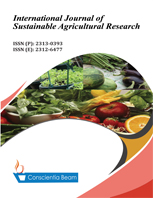Evaluation of Different Tillage Practices on Growth and Yield of Fluted Pumpkin Telfairia Occidentalis in Uyo, Southeastern Nigeria
DOI:
https://doi.org/10.18488/journal.70.2017.42.45.49Abstract
A study was conducted at University of Uyo Teaching and Research farm to evaluate the effect of different tillage practices on growth and yield of fluted pumpkin in an ultisol. The treatments were no till, flat, surface hoeing, raised bed, mounds and ridges. The parameters studied were establishment percentage, number of leaves per plant, vine length, leaf area, number of branches, and number of pods, length and circumference of pods as well as pod yield in tons per hectare. Data collected were subjected to analysis of variance and means were compared using least significant difference (LSD) at 5% probability level. There was no significant difference in the establishment count. However, significant differences occurred in all other parameters studied. Best results were obtained from the ridges and mounds over the other tillage practices. Ridges and mounds are therefore encouraged for increased production of fluted pumpkin.

